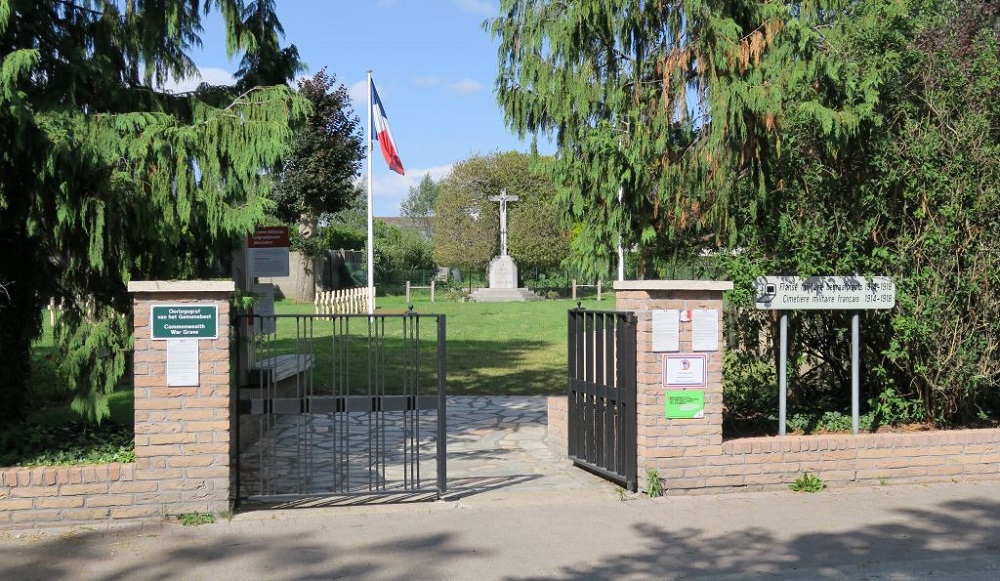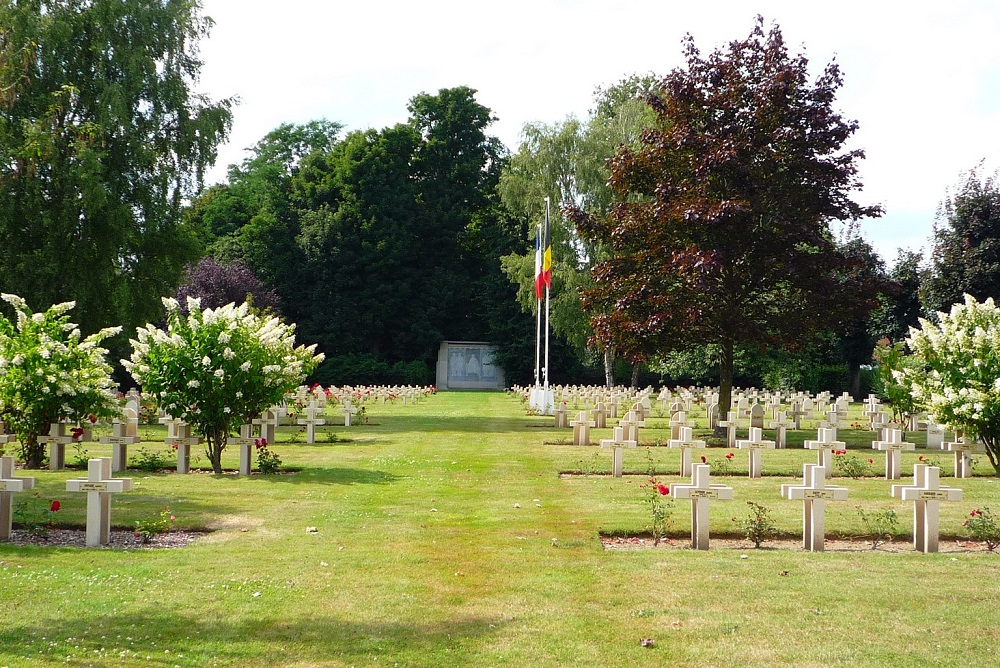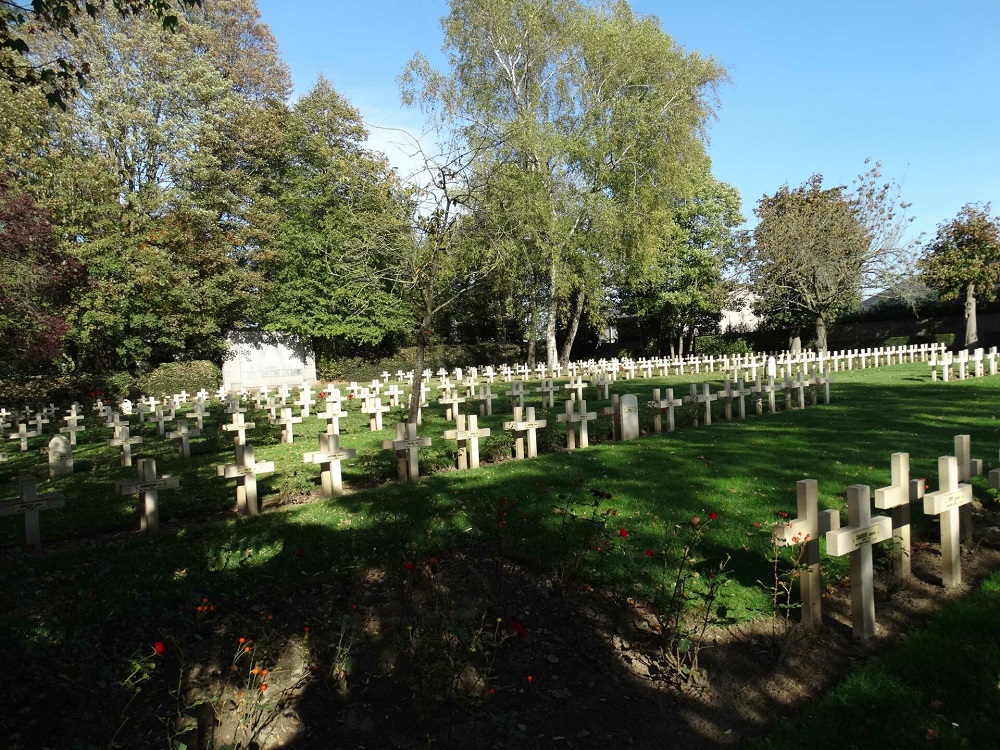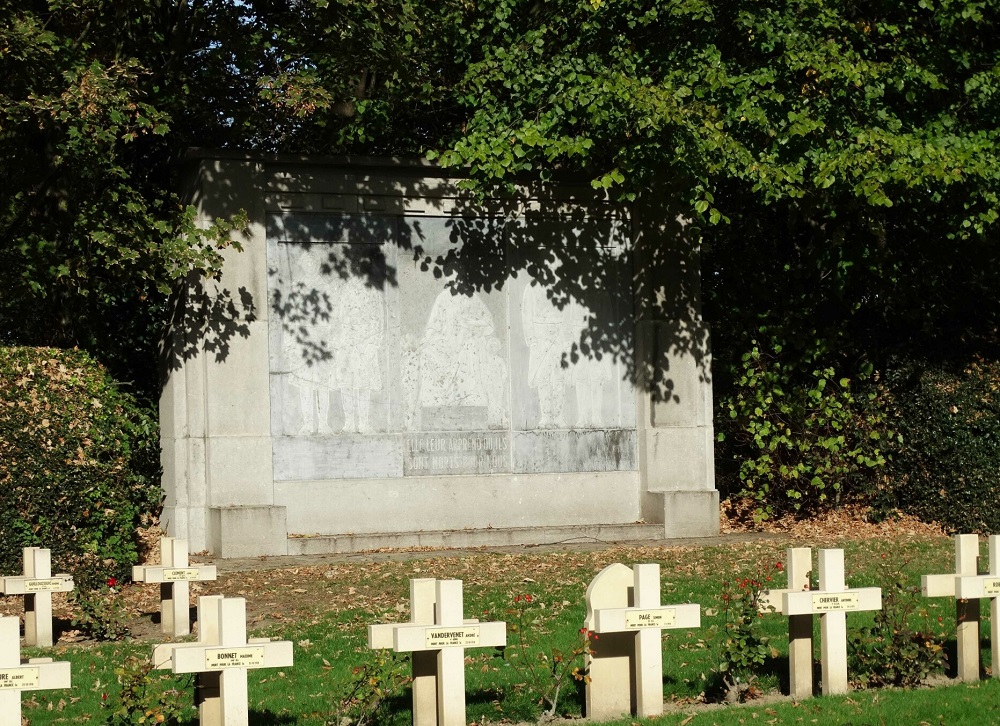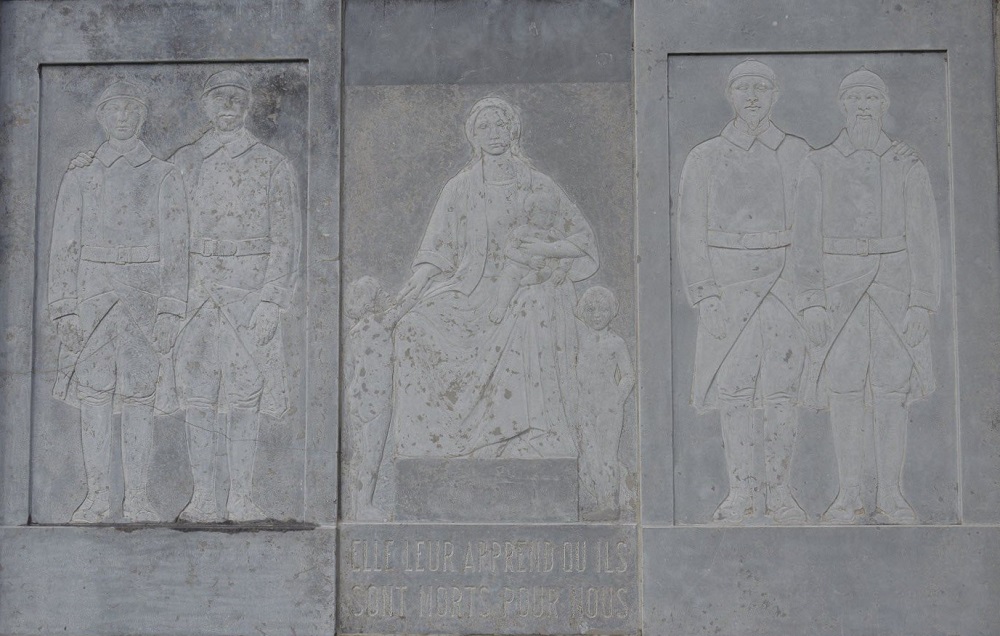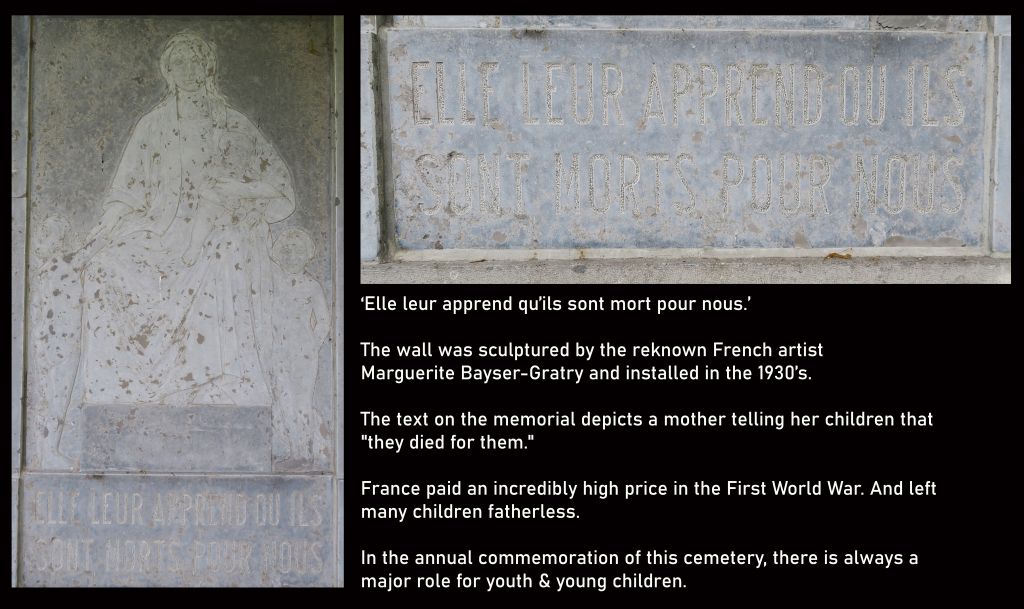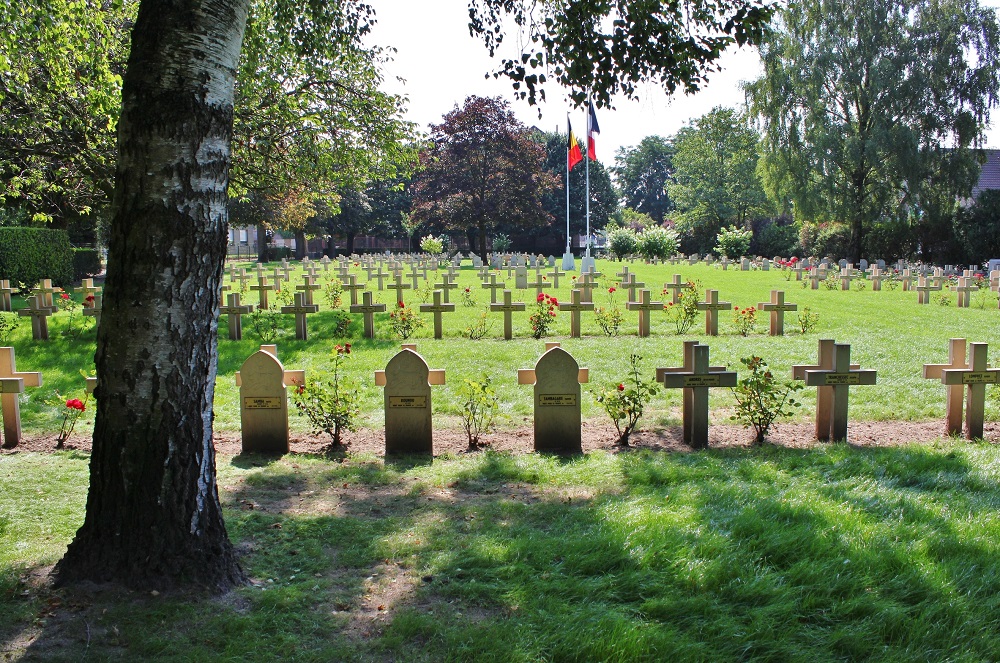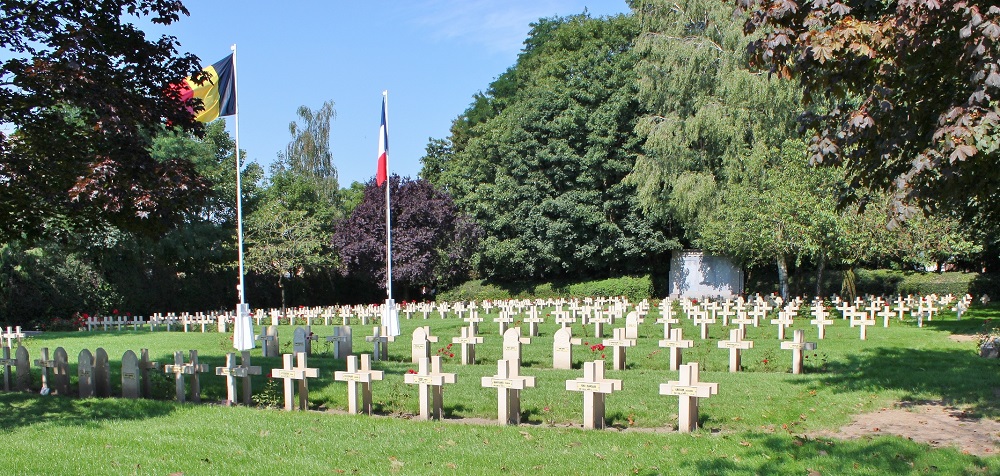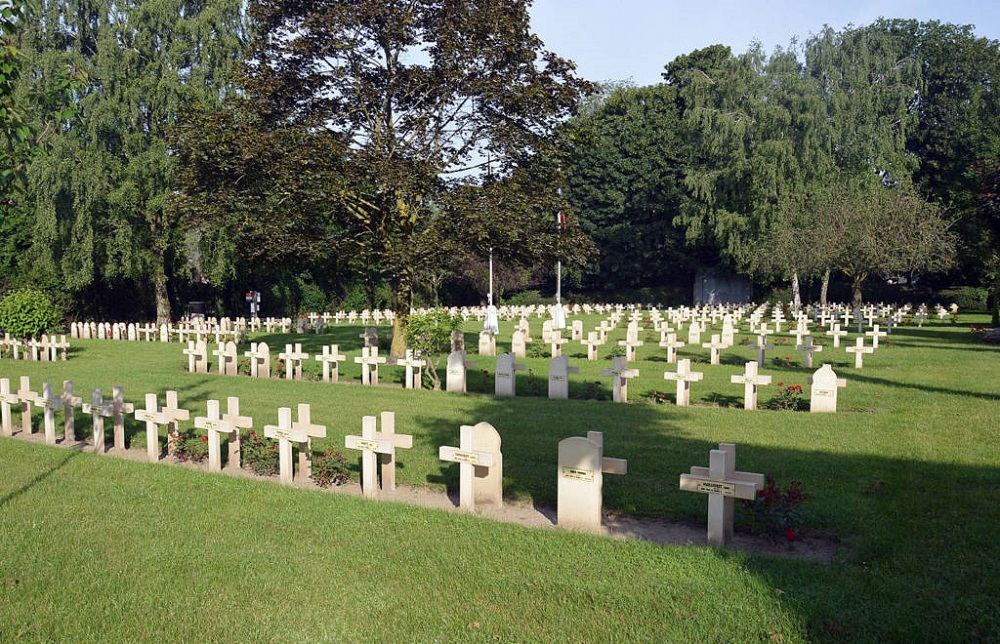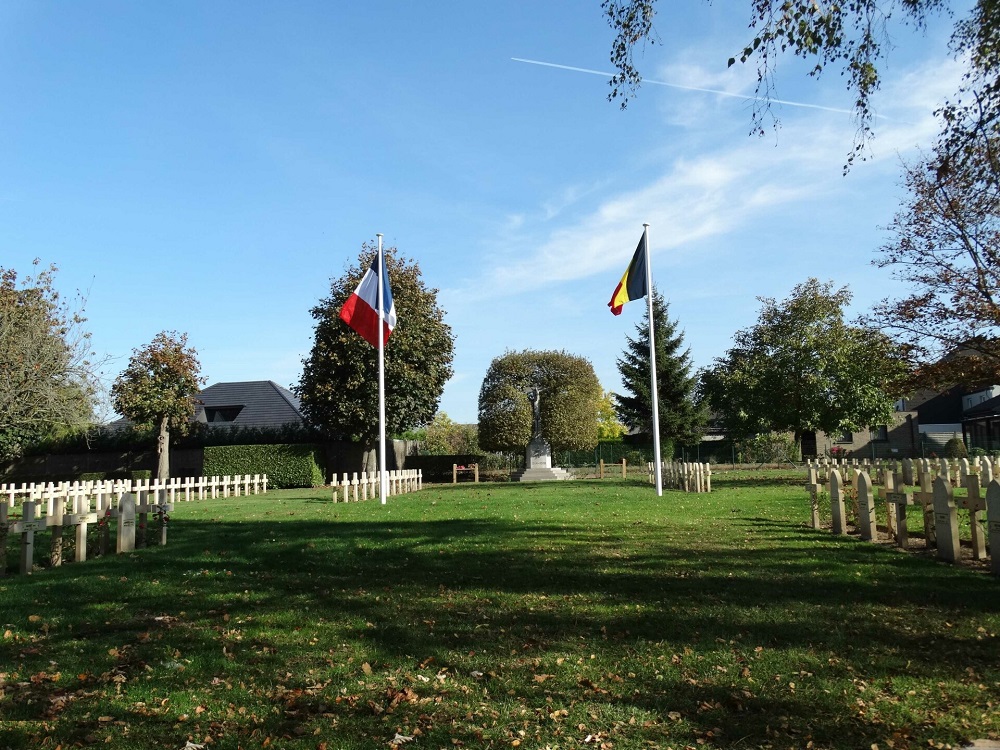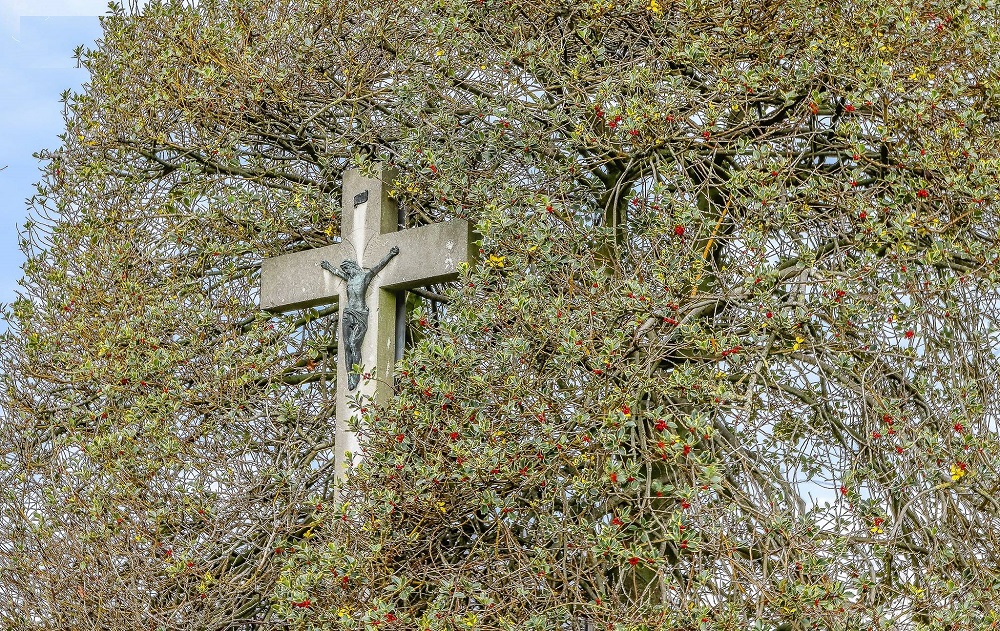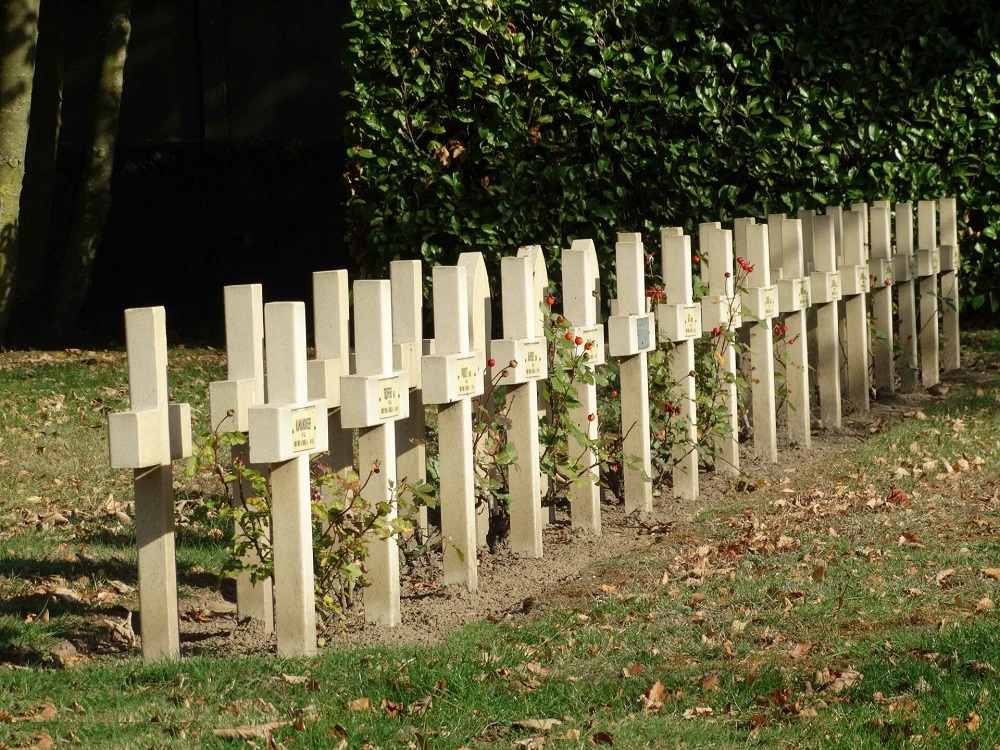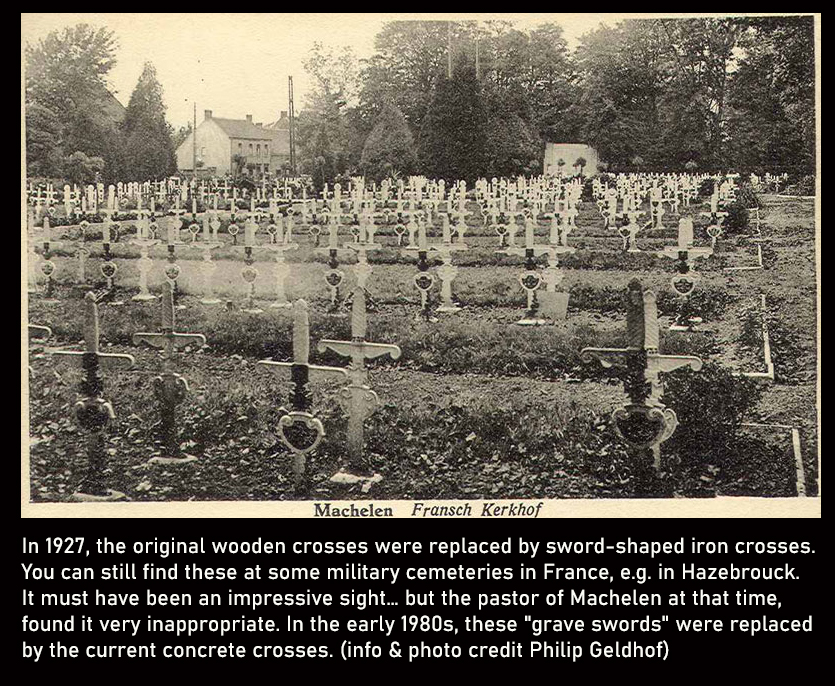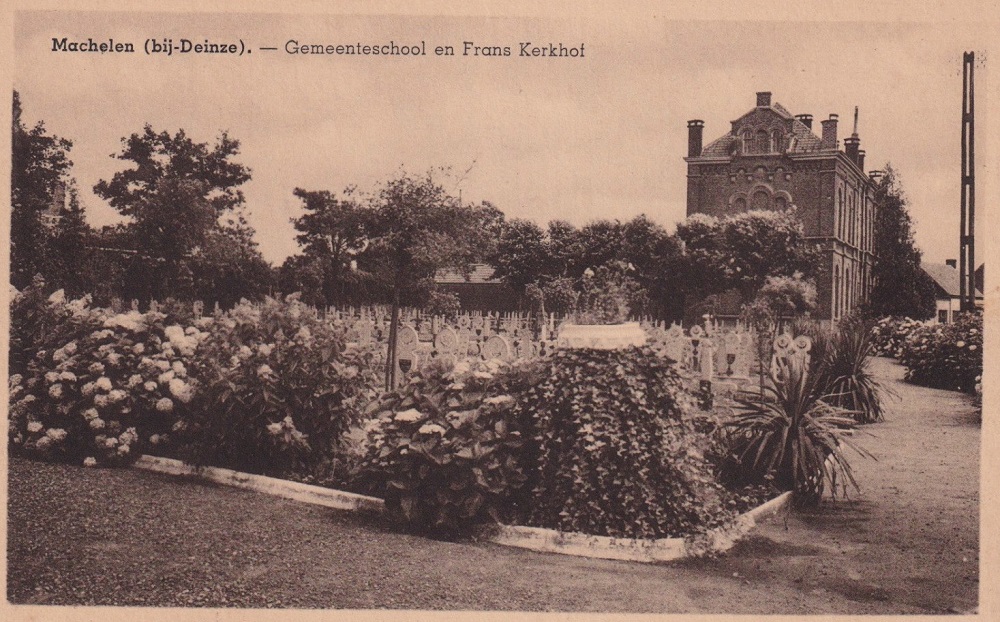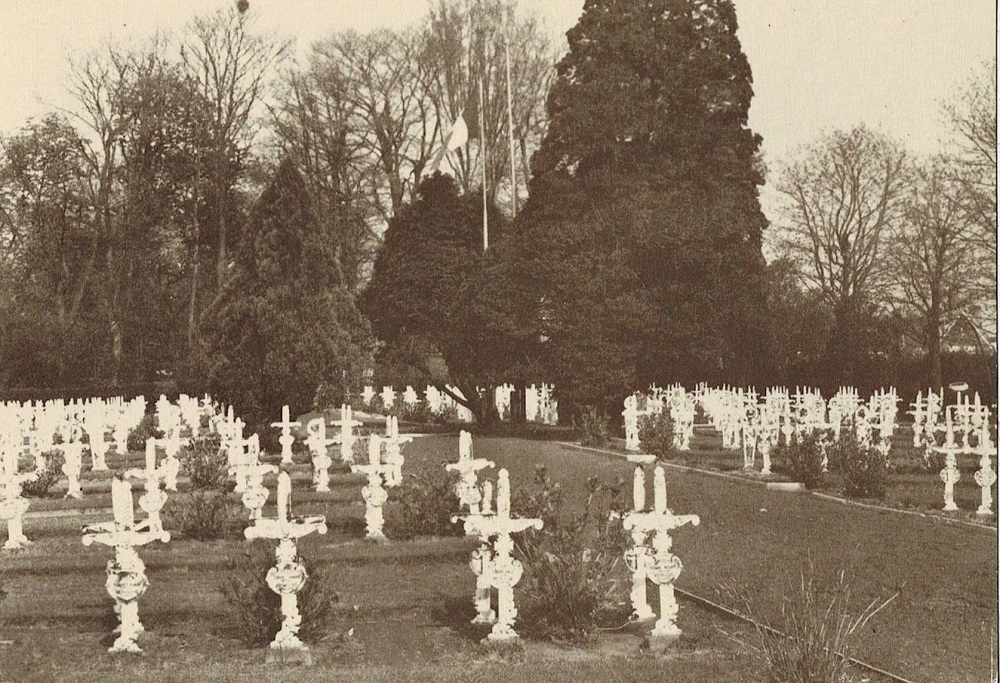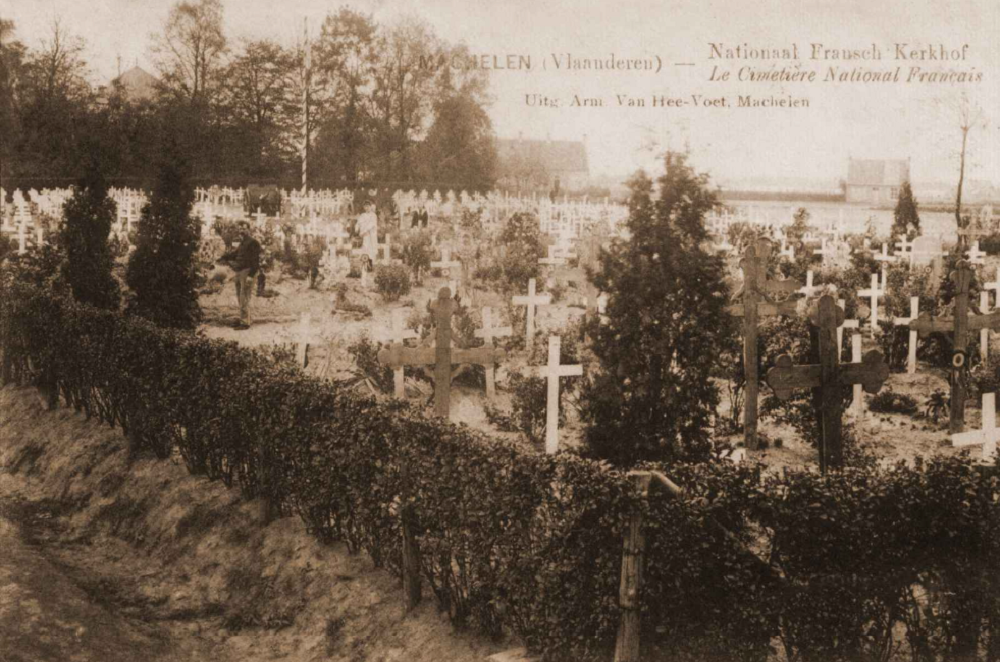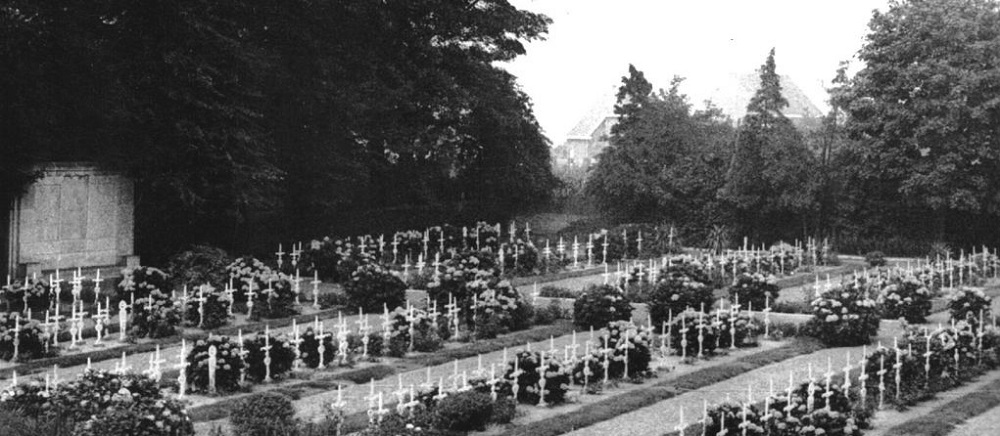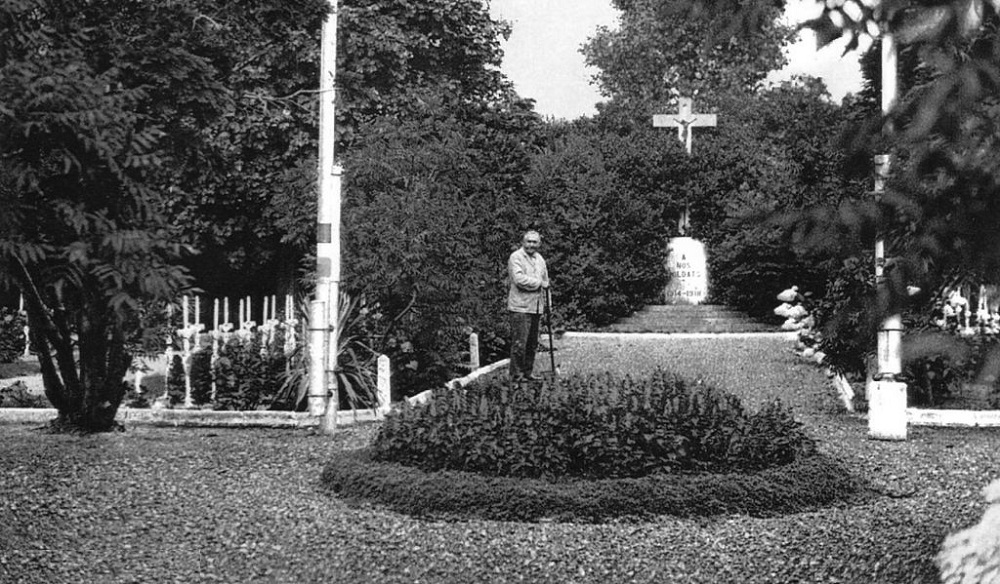Ligging - Localisation : Dorpsstraat.
GPS-coördinaten - Coordonnées GPS :
+50°57'30.0", +3°29'24.3"
Opschriften - Inscriptions
Monument - Monument
"ELLE LEUR APPREND QU'ILS
SONT MORTS POUR NOUS"
Vertaling - Traduction :
Ze leert hen dat ze voor ons stierven.
Gedenkkruis - Croix commémorative - Memorial Cross
"À
NOS
SOLDATS
1914-1918"
Vertaling - Traduction : Aan onze soldaten,
1914-1918.
Beschrijving - Description - Description
 De Franse militaire begraafplaats van Machelen is een
militaire begraafplaats met Franse gesneuvelden uit de
Eerste Wereldoorlog. Naast de Franse begraafplaats van
Saint-Charles de Potyze is het de tweede grootste Franse
militaire begraafplaats in België. Er staat een gedenkkruis,
naar ontwerp van G. Lefèvre, en een gedenkmuur met een
sculptuur van de Franse beeldhouwster Marguerite
Bayser-Gratry. Er worden 750 doden herdacht. In de laatste
maanden van W.O.I werd er nog zwaar gevochten aan de Leie.
De Duitse bezetter wilde zijn gunstige stellingen aan de
Leie niet prijsgeven. Hier in de streek gingen de Franse
troepen de bloedige strijd aan met de Duitsers. De Franse
soldaten wonnen het pleit, maar dit ging gepaard met zware
verliezen. Deze begraafplaats is de verzamelbegraafplaats
van bijna alle Franse militairen, die sneuvelden tijdens het
bevrijdingsoffensief van oktober 1918. Opvallend zijn de
vele graftekens die de verschillende geloofsovertuigingen
van de slachtoffers weergeven. De graven van soldaten uit de
toenmalige Noord-Afrikaanse kolonies vallen op door hun
islamitische grafzerken. Er ligt ook één Chinees begraven (hij
behoorde bij het arbeiderskorps) en een Anamite (arbeider
uit het centrum van het huidige Vietnam). Er ligt ook een
Britse piloot, Lt. Philip Frederick Cormack begraven.
Oorspronkelijk lag hij onder een Frans kruis begraven maar
na onderzoek door het documentatiecentrum van Flanders
Field, werd hij als Britse RAF-piloot erkend. Hij sneuvelde
op 27 oktober 1918. Philip Frederick Cormack stond ook als
vermist vermeld in Arras op de gedenkplaat van "The Arras
Flying Services Memorial". Einde 2013 werd dit Frans kruis
vervangen door de gebruikelijke Britse witte grafzerk.(Bron
: Facebook pagina "Visiting
the Western Front of the Great War")
De Franse militaire begraafplaats van Machelen is een
militaire begraafplaats met Franse gesneuvelden uit de
Eerste Wereldoorlog. Naast de Franse begraafplaats van
Saint-Charles de Potyze is het de tweede grootste Franse
militaire begraafplaats in België. Er staat een gedenkkruis,
naar ontwerp van G. Lefèvre, en een gedenkmuur met een
sculptuur van de Franse beeldhouwster Marguerite
Bayser-Gratry. Er worden 750 doden herdacht. In de laatste
maanden van W.O.I werd er nog zwaar gevochten aan de Leie.
De Duitse bezetter wilde zijn gunstige stellingen aan de
Leie niet prijsgeven. Hier in de streek gingen de Franse
troepen de bloedige strijd aan met de Duitsers. De Franse
soldaten wonnen het pleit, maar dit ging gepaard met zware
verliezen. Deze begraafplaats is de verzamelbegraafplaats
van bijna alle Franse militairen, die sneuvelden tijdens het
bevrijdingsoffensief van oktober 1918. Opvallend zijn de
vele graftekens die de verschillende geloofsovertuigingen
van de slachtoffers weergeven. De graven van soldaten uit de
toenmalige Noord-Afrikaanse kolonies vallen op door hun
islamitische grafzerken. Er ligt ook één Chinees begraven (hij
behoorde bij het arbeiderskorps) en een Anamite (arbeider
uit het centrum van het huidige Vietnam). Er ligt ook een
Britse piloot, Lt. Philip Frederick Cormack begraven.
Oorspronkelijk lag hij onder een Frans kruis begraven maar
na onderzoek door het documentatiecentrum van Flanders
Field, werd hij als Britse RAF-piloot erkend. Hij sneuvelde
op 27 oktober 1918. Philip Frederick Cormack stond ook als
vermist vermeld in Arras op de gedenkplaat van "The Arras
Flying Services Memorial". Einde 2013 werd dit Frans kruis
vervangen door de gebruikelijke Britse witte grafzerk.(Bron
: Facebook pagina "Visiting
the Western Front of the Great War")
 Le cimetière militaire français de Machelen est un cimetière
militaire avec des morts de guerre français de la Première
Guerre mondiale. Outre le cimetière français de
Saint-Charles de Potyze, c'est le deuxième plus grand
cimetière militaire français de Belgique. Il y a une croix
commémorative, conçue par G. Lefèvre, et un mur commémoratif
avec une sculpture du sculpteur français Marguerite
Bayser-Gratry. 750 morts sont commémorés. Dans les derniers
mois de la Première Guerre mondiale, il y avait encore de
violents combats sur la Lys. L'occupant allemand ne voulait
pas renoncer à ses positions favorables sur la Lys. Ici,
dans la région, les troupes françaises se sont engagées dans
une bataille sanglante avec les Allemands. Les soldats
français ont gagné, mais cela s'est accompagné de lourdes
pertes. Ce cimetière est le cimetière collectif de presque
tous les soldats français tombés lors de l'offensive de
libération en octobre 1918. Remarquables sont les nombreux
monuments commémoratifs qui dépeignent les différentes
croyances des victimes. Les tombes de soldats des colonies
d'Afrique du Nord d'alors sont remarquables pour leurs
pierres tombales islamiques. Il y a aussi un Chinois enterré
(il appartenait au corps ouvrier) et un Anamite (ouvrier du
centre du Vietnam actuel). Il y a aussi un pilote
britannique, le lieutenant Philip Frederick Cormack. À
l'origine, il a été enterré sous une croix française, mais
après enquête du centre de documentation de Flanders Field,
il a été reconnu comme pilote de la RAF britannique. Il fut
tué le 27 octobre 1918. Philip Frederick Cormack était
également porté disparu à Arras sur la plaque du Mémorial
des services aériens d'Arras. Fin 2013, cette croix
française a été remplacée par l'habituelle pierre tombale
blanche britannique.(Source : Page Facebook "Visiting
the Western Front of the Great War")
Le cimetière militaire français de Machelen est un cimetière
militaire avec des morts de guerre français de la Première
Guerre mondiale. Outre le cimetière français de
Saint-Charles de Potyze, c'est le deuxième plus grand
cimetière militaire français de Belgique. Il y a une croix
commémorative, conçue par G. Lefèvre, et un mur commémoratif
avec une sculpture du sculpteur français Marguerite
Bayser-Gratry. 750 morts sont commémorés. Dans les derniers
mois de la Première Guerre mondiale, il y avait encore de
violents combats sur la Lys. L'occupant allemand ne voulait
pas renoncer à ses positions favorables sur la Lys. Ici,
dans la région, les troupes françaises se sont engagées dans
une bataille sanglante avec les Allemands. Les soldats
français ont gagné, mais cela s'est accompagné de lourdes
pertes. Ce cimetière est le cimetière collectif de presque
tous les soldats français tombés lors de l'offensive de
libération en octobre 1918. Remarquables sont les nombreux
monuments commémoratifs qui dépeignent les différentes
croyances des victimes. Les tombes de soldats des colonies
d'Afrique du Nord d'alors sont remarquables pour leurs
pierres tombales islamiques. Il y a aussi un Chinois enterré
(il appartenait au corps ouvrier) et un Anamite (ouvrier du
centre du Vietnam actuel). Il y a aussi un pilote
britannique, le lieutenant Philip Frederick Cormack. À
l'origine, il a été enterré sous une croix française, mais
après enquête du centre de documentation de Flanders Field,
il a été reconnu comme pilote de la RAF britannique. Il fut
tué le 27 octobre 1918. Philip Frederick Cormack était
également porté disparu à Arras sur la plaque du Mémorial
des services aériens d'Arras. Fin 2013, cette croix
française a été remplacée par l'habituelle pierre tombale
blanche britannique.(Source : Page Facebook "Visiting
the Western Front of the Great War")
 The French military cemetery of Machelen is a military
cemetery with French war dead from the First World War.
Besides the French cemetery of Saint-Charles de Potyze, it
is the second largest French military cemetery in Belgium.
There is a memorial cross, designed by G. Lefèvre, and a
memorial wall with a sculpture by the French sculptor
Marguerite Bayser-Gratry. 750 dead are commemorated. In the
last months of WWI there was still heavy fighting on the
Leie. The German occupier did not want to give up its
favorable positions on the Leie. Here in the region, the
French troops engaged in a bloody battle with the Germans.
The French soldiers won, but this was accompanied by heavy
losses. This cemetery is the collective cemetery of almost
all French soldiers who fell during the liberation offensive
in October 1918. Remarkable are the many memorials that
depict the different beliefs of the victims. The graves of
soldiers from the then North African colonies are notable
for their Islamic gravestones. There is also one Chinese
buried (he belonged to the workers' corps) and an Anamite (worker
from the center of present-day Vietnam). There is also a
British pilot, Lt. Philip Frederick Cormack. Originally he
was buried under a French cross, but after investigation by
the Flanders Field documentation center, he was recognized
as a British RAF pilot. He was killed on October 27, 1918.
Philip Frederick Cormack was also listed as missing in Arras
on the plaque of The Arras Flying Services Memorial. At the
end of 2013, this French cross was replaced by the usual
British white gravestone. (Source : Facebook
page "Visiting
the Western Front of the Great War")
The French military cemetery of Machelen is a military
cemetery with French war dead from the First World War.
Besides the French cemetery of Saint-Charles de Potyze, it
is the second largest French military cemetery in Belgium.
There is a memorial cross, designed by G. Lefèvre, and a
memorial wall with a sculpture by the French sculptor
Marguerite Bayser-Gratry. 750 dead are commemorated. In the
last months of WWI there was still heavy fighting on the
Leie. The German occupier did not want to give up its
favorable positions on the Leie. Here in the region, the
French troops engaged in a bloody battle with the Germans.
The French soldiers won, but this was accompanied by heavy
losses. This cemetery is the collective cemetery of almost
all French soldiers who fell during the liberation offensive
in October 1918. Remarkable are the many memorials that
depict the different beliefs of the victims. The graves of
soldiers from the then North African colonies are notable
for their Islamic gravestones. There is also one Chinese
buried (he belonged to the workers' corps) and an Anamite (worker
from the center of present-day Vietnam). There is also a
British pilot, Lt. Philip Frederick Cormack. Originally he
was buried under a French cross, but after investigation by
the Flanders Field documentation center, he was recognized
as a British RAF pilot. He was killed on October 27, 1918.
Philip Frederick Cormack was also listed as missing in Arras
on the plaque of The Arras Flying Services Memorial. At the
end of 2013, this French cross was replaced by the usual
British white gravestone. (Source : Facebook
page "Visiting
the Western Front of the Great War")
Beeldhouwer - Sculpteur - Sculptor
- Sculptuur - Sculpture - Sculpture : Marguerite
BAYSER-GRATRY.
- Gedenkkruis - Croix commémorative - Memorial Cross : G.
LEFÈVRE.
Zie namen op de graven - Voir les noms gravés sur les tombes
|
